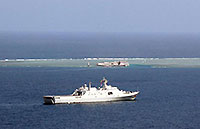US import prices post first drop in six months, but trend improving
(Agencies) Updated: 2016-09-15 01:34US import prices fell for the first time in six months in August on weak petroleum and food costs, but the declining trend is slowing as oil prices stabilize and the dollar's rally fades.
Still, Wednesday's report from the Labor Department suggested the near-term inflation outlook would remain tame, strengthening the argument for the Federal Reserve to keep interest rates steady next week.
Import prices slipped 0.2 percent last month after gaining 0.1 percent in July. August's drop was the first since February and was led by a 2.8 percent decline in petroleum prices. Imported petroleum prices fell 3.6 percent in July.
In the 12 months through August, import prices fell 2.2 percent, the smallest decrease since October 2014, after declining 3.7 percent in July.
"Most Fed officials expect the gradual climb toward the inflation target to remain intact and the diminishing drag from import price deflation will help, but it's going to take time," said Sam Bullard, a senior economist at Wells Fargo Securities in Charlotte, North Carolina. "We expect the Fed to remain cautious, leaving rates unchanged next week."
August's weak inflation reading added to slower job growth, soft manufacturing and services sectors surveys in reducing the likelihood of an interest rate hike at the Fed's Sept. 20-21 policy meeting.
Fed Governor Lael Brainard said on Monday she wanted to see stronger consumer spending data and signs of rising inflation before raising interest rates.
The U.S. central bank lifted its benchmark overnight interest rate at the end of last year for the first time in nearly a decade, but has held it steady since amid concerns over persistently low inflation.
U.S. financial markets were little moved by the data.
DOLLAR, OIL DRAG WANING
Import prices have been constrained by dollar strength and cheap oil. That, together with sluggish wage growth, has left inflation persistently running below the Fed's 2 percent target. But the dollar rally appears to have peaked early this year and oil prices have pushed off multi-decade lows.
Import prices excluding petroleum were unchanged in August after climbing 0.5 percent in July. They were down 0.9 percent in the 12 months through August, the smallest year-on-year decrease since December 2014.
"In spite of the month-to-month volatility, we view the underlying trend in imported deflation as improving and consistent with a gradual waning of the drag from the stronger dollar and lower global commodity prices," said Blerina Uruci, an economist at Barclays in Washington.
"We expect an improvement in imported inflation to help stabilize domestic core goods prices in the coming months."
The nation continued to import deflation from China, with the cost of goods imported from that country falling 0.2 percent last month. Prices for Chinese imports have not recorded a monthly increase since December 2014.
August's decrease was led by a 1.0 percent decline in the price of imported communications equipment. There were also declines in the cost of imported goods from Canada, the European Union and Mexico. The cost of imports from Japan, however, rose 0.3 percent, the largest gain since August 2011.
Overall prices for imported capital goods were unchanged last month, while the cost of imported automobiles fell 0.2 percent. Imported consumer goods prices excluding automobiles slipped 0.1 percent and the cost of imported food decreased 0.5 percent last month.
The report also showed export prices fell 0.8 percent in August. That was the biggest drop since January and followed a 0.2 percent increase the prior month. Export prices were down 2.4 percent from a year ago.







